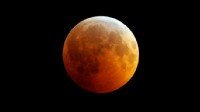Summer Solstice: 4 Myths About the Sun's Ascension

From Chalchuapa, El Salvador, to Stonehenge in England, people are honoring the summer solstice today as the sun ascends to the highest point in the sky in the Northern Hemisphere.
But misconceptions about the summer solstice are common, according to astronomer Larry Ciupik at the Adler Planetarium and Astronomy Museum in Chicago.
So today, the first day of summer (and the longest day of the year), we examine four myths about the summer solstice.
Myth No. 1: The Seasons Change Because of the Earth's Distance From the Sun
Ciupik, who teaches college students at Indiana University Northwest, says one of the biggest misunderstandings about the summer solstice is that it is related to the Earth's distance from the sun. But the Earth rotates around the sun in an almost circular orbit, so the distance between sun and Earth doesn't change very much.
Debunking Health Myths Watch Video
Lunar Eclipse on the Winter SolsticeWatch Video
Lunar Eclipse on the Solstice Watch Video
This year, Ciupik said, the Earth was closest to the sun Jan. 3rd and will be farthest away July 4.
"So the distance effect isn't the reason for the summer or season change; they change because the Earth is tilted," he said.
In other words, although the sun is farther away from the Earth during the summer solstice in the Northern Hemisphere, the Earth is tilted toward the sun, and the noon rays hit directly overhead the Tropic of Cancer. But during the winter, when the sun is somewhat closer, the Earth is tilted away from the sun.
The Latin translation of solstice means the sun, standing still; that's because it is about to start descending. After the solstice, the sun's altitude will decrease and the sunlight will become less direct.
Myth No. 2: Summer Solstice Is the Hottest Day of the Year
It's commonly assumed that because the sun's rays are hitting the Earth more directly, the summer solstice is the hottest day of the year. But it takes time for the Earth to heat up. So, in reality, the summer solstice brings the greatest amount of light to the Northern Hemisphere, not the greatest amount of heat.
"The hottest days are weeks later, on the average," Ciupik said. "The same thing is true in the winter. The winter solstice is Dec. 21; weeks later you get the coldest days."
Local conditions can cause exceptions to this general rule.
Myth No. 3: Behold the 'Egg-quinox': You Can Balance Eggs Upright on a Table
You might not have heard this one: Some people believe that you're more likely to balance eggs upright on a flat surface during the spring equinox when the Earth's axis does not point toward or away from the sun.
But balancing an egg isn't any more likely during the equinox, or the summer solstice, for that matter. It is a misconception that the Earth's axis is somehow shifting in response to the changing seasons.
In reality, Ciupik says, you can easily balance eggs upright on a table any day of the year.
Here's how: take a dozen eggs and shake each one until the yolks break up a bit inside the shell so that it can move more freely. Next, put the egg back in the carton to settle the yolk further down. When you try placing the egg on a flat surface it will stand upright because it has become more weighted at the bottom.
"It's such a cool thing to do because nobody believes it," Ciupik said.
Myth No. 4: Druids Celebrate Summer Solstice Because They Are Worshipping the Sun
Konstantin Zavrazhin/Getty Images
Russians celebrating the summer solstice... View Full Size
Debunking Health Myths Watch Video
Lunar Eclipse on the Winter SolsticeWatch Video
Lunar Eclipse on the Solstice Watch Video
John Matthews, a historian who wrote the book "Summer Solstice: Celebrating the Journey of the Sun From May Day to Harvest," says people often assume modern-day Druids are sun-worshippers, but "that's not quite true."
"We're celebrating the very necessity of having that light to keep things going," he said.
Matthews, who lives in Oxford, England, has been honoring the solstices for nearly 30 years and has been a Druid for just as long. He observed the summer solstice this year with a small group of friends Monday night.
In the past, however, he would go to Stonehenge and watch the sun rise. Even three decades later, he says, there's still a sense of wonder when the sun arrives.
"There's always an audible gasp when that happens," he said. "Even when we understand the science of it all; there's a tiny atavistic part of us that isn't quite sure it's going to come up."
The Druids are misunderstood for another reason, he says, because most people assume they are Celtic.
In reality, he said, "They originated before the Celtic people came to Britain."
At that time, he said, Druids believed in the sanctity of the sun and worshipped the sun.
But today, for Matthews, the solstices are about appreciating the Earth's source of light, food, energy and health.
"The idea of lighting a fire on midsummer and also midwinter is to welcome in the sun and remind the sun that we're here," he said.




Tidak ada komentar:
Posting Komentar